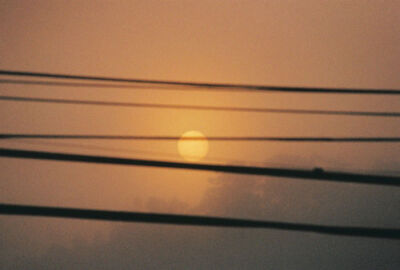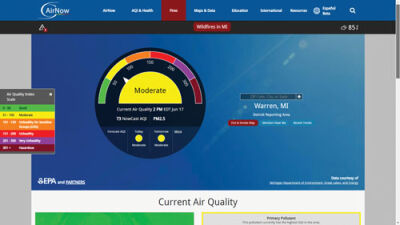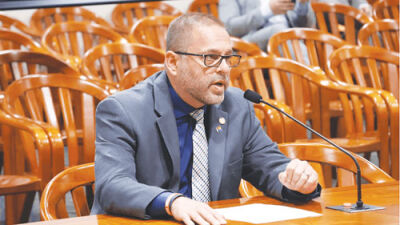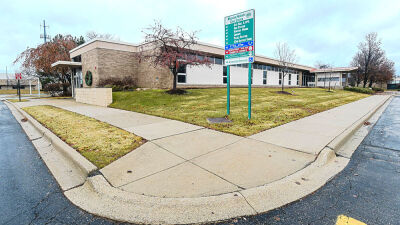
Hazy air, noticeable at sunrise and sunset, may contain wildfire smoke. Particulate matter from wildfires can feature everything from tree ashes to industrial chemicals.
Photo by Dean Vaglia

The Environmental Protection Agency’s airnow.gov website allows for quick air quality index readings searchable by city name or ZIP code. A guide to AQI ratings is available in a tab on the website’s main page.
Screenshot taken from airnow.gov
METRO DETROIT — Over the past few years, summer skies have been marked by the presence of an abnormal haze. While this has done a number to cloud out sunrises and sunsets, the midsummer haze can also pose a health risk.
Air pollution has long been a factor in metro Detroit, and it is not particularly hard to explain why. The history of manufacturing in the area along with the region’s love of automobiles leads to many industrial-related pollutants making their way into the air we breathe.
“We occasionally go over the air quality standard for ozone and for sulfur dioxide,” said Mozhgon Rajaee, an Oakland University environmental health sciences professor. “The sulfur dioxide is mostly exceeded in the Detroit area … and that’s because there’s a lot of industry in Detroit, southwest Detroit and parts of Wayne County.”
But as wildfire season heats up in May, smoke from the west coast, Canada and even northern Michigan makes its way east and through the Detroit area. Drifting wildfire smoke is full of particulate matter air pollutants, which are solid, inhalable debris classified by its size in 10 micrometers or 2.5 micrometers. What exactly composes particulate matter pollution depends on what had to be destroyed to produce it. As Rajaee puts it, particulate matter is made up of things.
“When a wildfire is happening, you’re burning trees,” Rajaee said. “You’re burning structures sometimes, if homes are burning. In some of the areas that are burning there was a lot of mining that happened … All those hazardous chemicals — metals, for example — that are tied up within those trees are liberated when you burn (the trees,) and so they get in the air. So, it’s possible this smoke contains heavy metals like arsenic, lead and mercury.”
In the short-term, breathing contaminated air can irritate respiratory systems. Extensive exposure to contaminated air can lead to lung diseases, heart attacks and even death in some cases.
The best way to make sure you are not exposing yourself to too much contaminated air — especially since pollutants like ozone can be strong on otherwise clear, sunny days — is to check the air quality index for your given area on a regular basis. The Environmental Protection Agency’s AirNow.gov website features AQI ratings by ZIP code, and the fire and smoke map allows users to interact with and inspect readings from air quality monitors around the U.S., Canada and Mexico.
Rajaee says healthy individuals can be active outside up to an AQI rating of 151, which starts the “unhealthy for everyone” category, while those with compromised immune systems and other health risk factors should limit outdoor activity to the “good” and “moderate” ratings.
“I would say 150 and above, that’s a good cutoff right there,” Rajaee said. “Even if you’re healthy, that poses a risk to your health. If the levels are above 150, I would encourage people to not do the outdoor activity; you can wait to mow your lawn or do yardwork, or if you planned an outdoor birthday party for your 12-year-old kid, maybe this is the time to figure out a way to move that inside.”
The future of metro Detroit’s air quality is as clear as a wildfire sunrise — quite hazy and not great to look at. Rajaee says dynamics of Canadian wildfires in particular are expected to get worse as the climate continues to change. Hotter temperatures in polar regions lead to drier forests, which are more prone to catching fire from lightning strikes during severe thunderstorms, which are also expected to increase in frequency.
Kelly Karll, manager of the environment and infrastructure group for the Southeast Michigan Council of Governments, says that air pollution has been decreasing throughout the region since the 2000s and as of mid-June, the regional organization was consulting with state and federal environmental agencies about updating a portion of Wayne County to confirm that it has reached attainment regarding sulfur dioxide pollution.
“We don’t have as much industry as we used to 20, 30 years ago, and that has had an improvement to (regional air quality,)” Karll said. “It’s really been a collaborative effort. Everybody plays a part. (The Michigan Department of Environment, Great Lakes and Energy) has instituted more stringent permit standards for industry. Industry has new technology that has improved air quality coming out of its point sources and stacks. Transportation and vehicles have improved. There’s been a push to replace diesel vehicles, and that’s been a big push over the decade or so. We certainly have electric vehicles reducing the amount of gas engines. There’s a lot of different pieces that fall into that.”
Even still, the problem of air pollution is a long way from being solved. And without mass efforts to make further changes — and no relief in sight from wildfires — both Rajaee and Karll recommend people take precautions to limit exposure and contributions to air pollution. People are encouraged to stay indoors on days when the AQI rating is high and to not add to the pollution by running engines during the day. If you must go out, exposure can be limited by keeping car windows closed and wearing a mask if you will be outside for an extended period of time.
 Publication select ▼
Publication select ▼






















